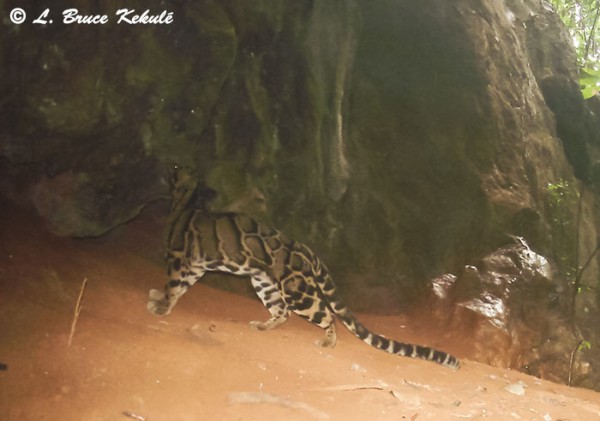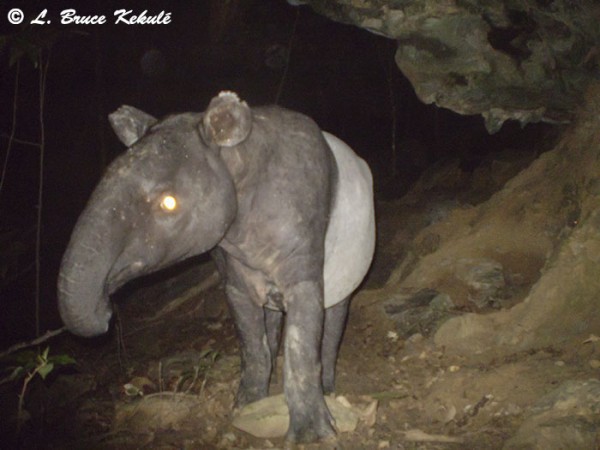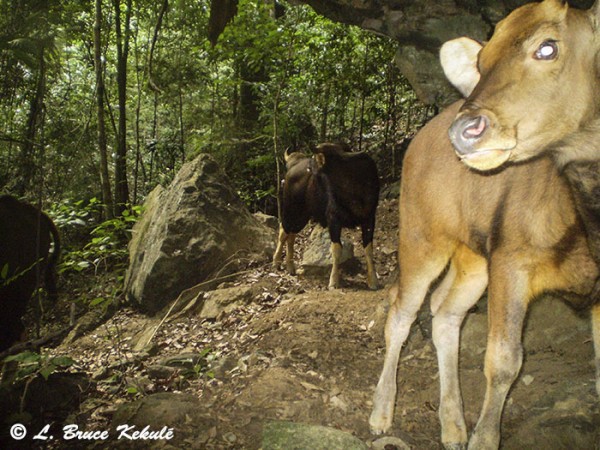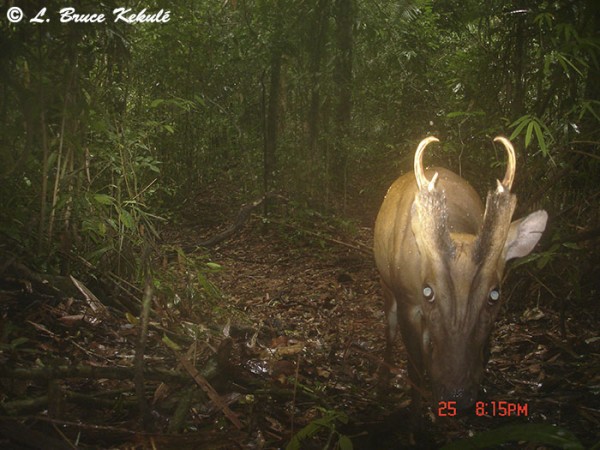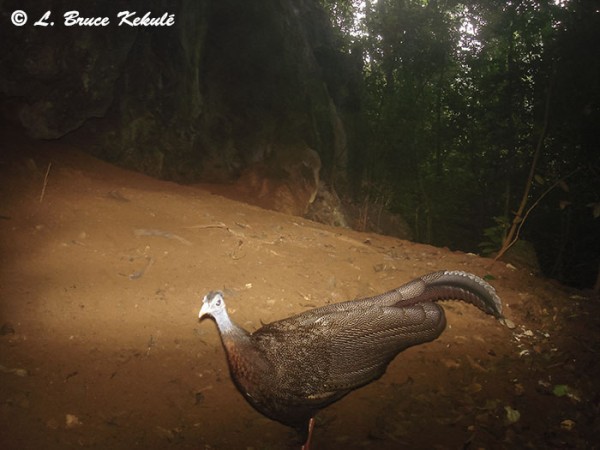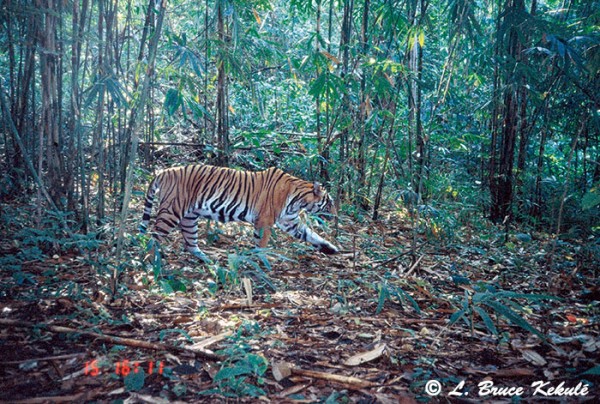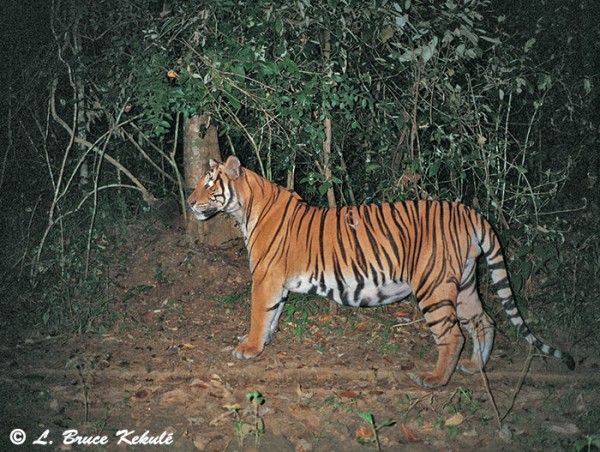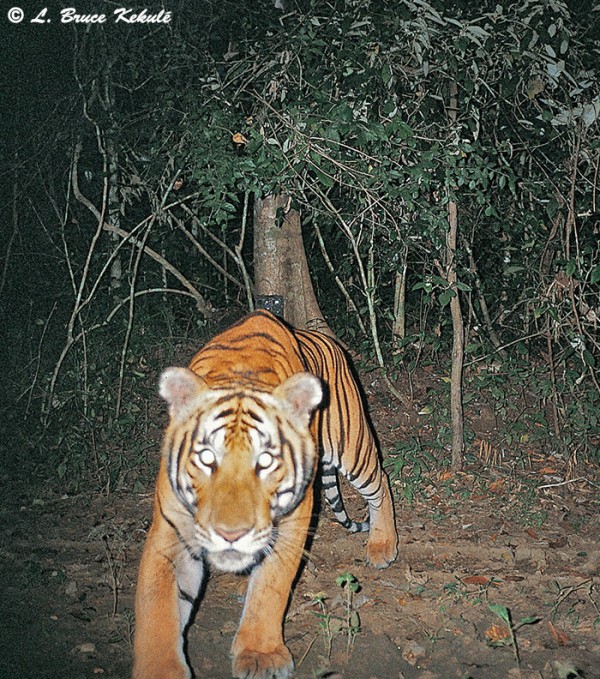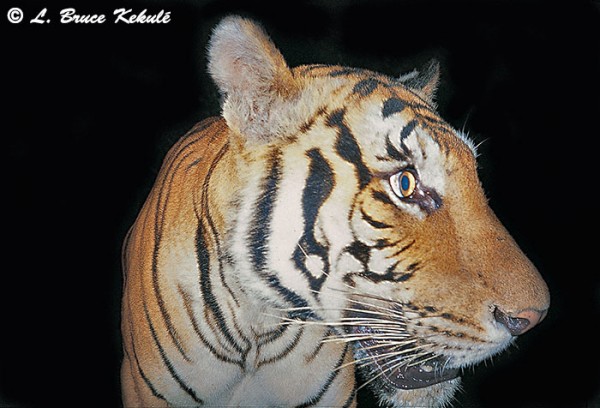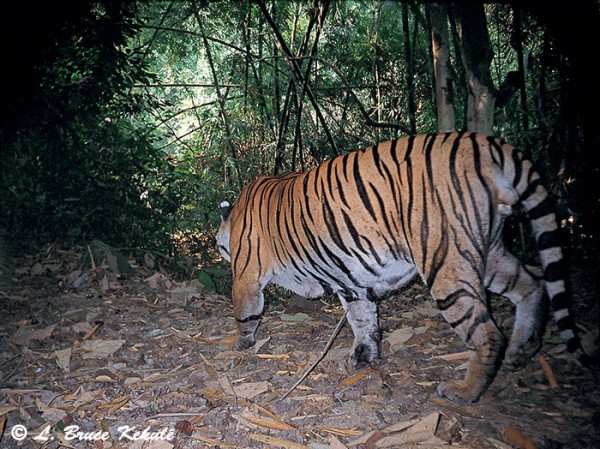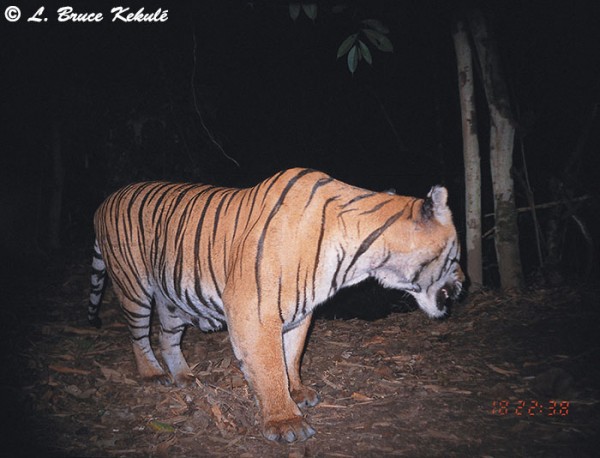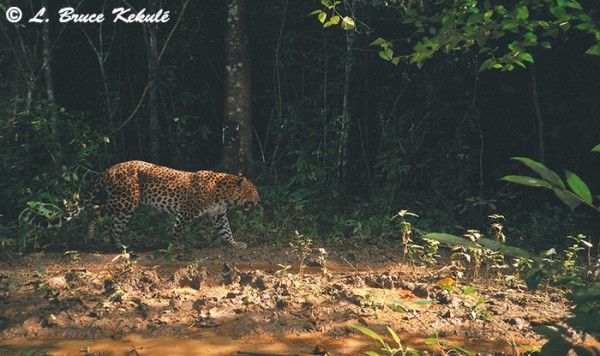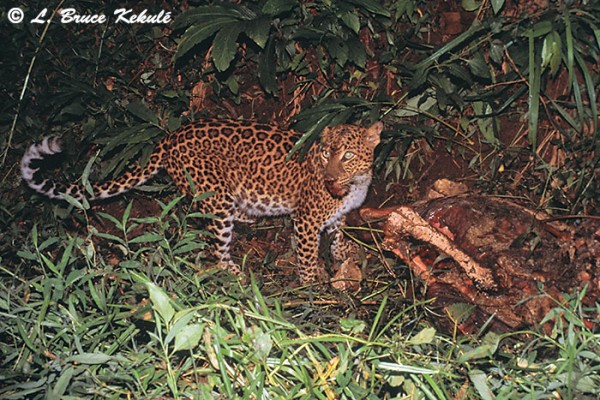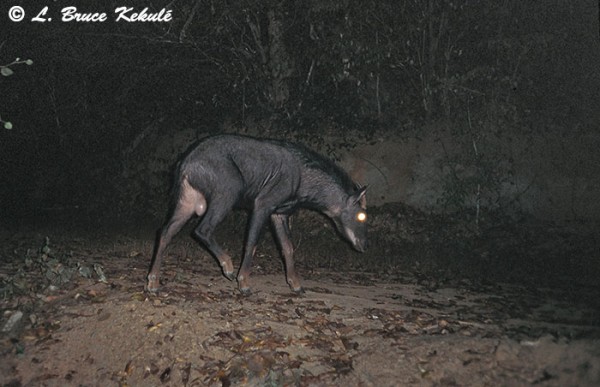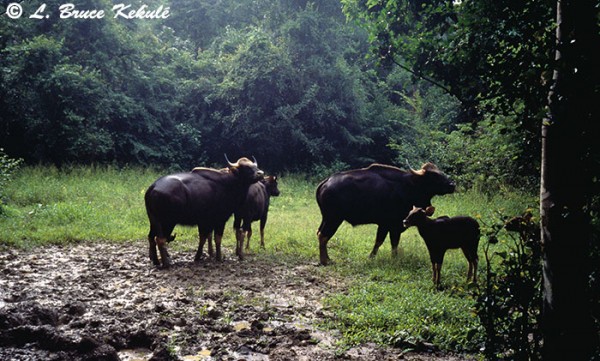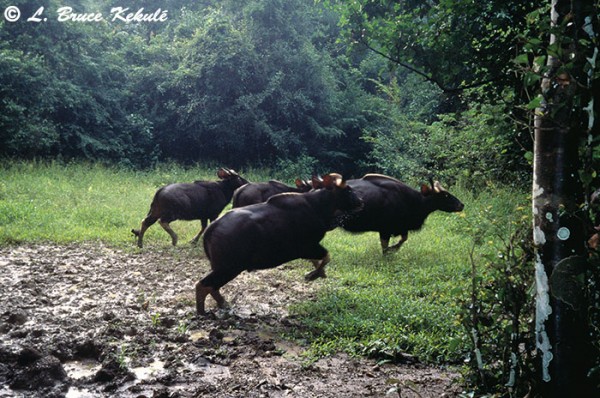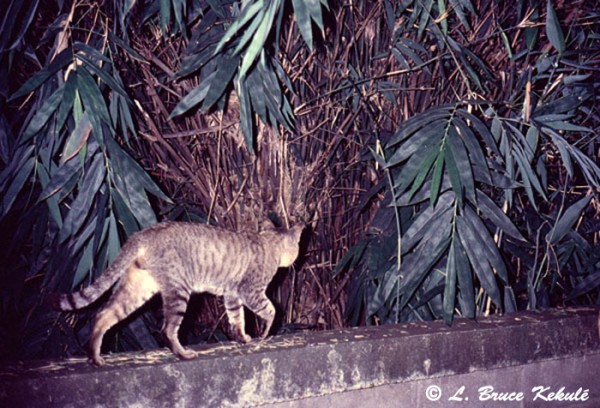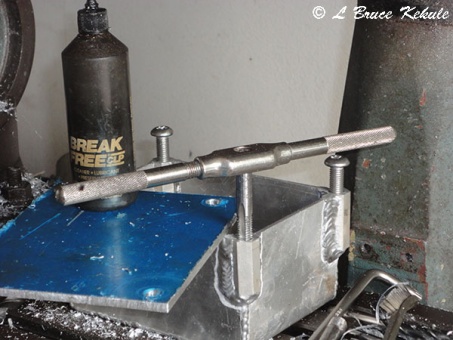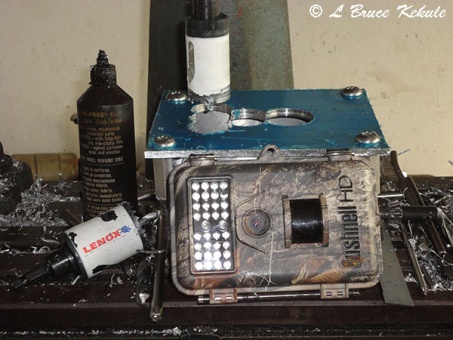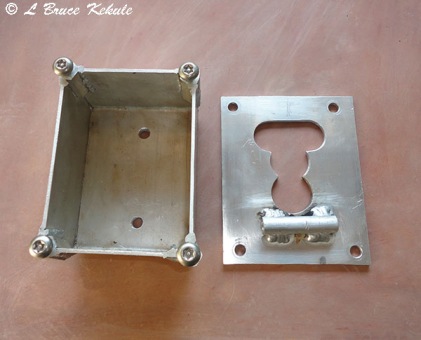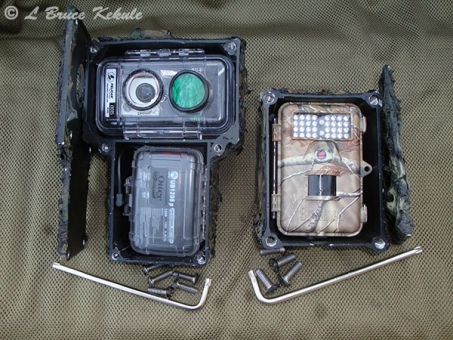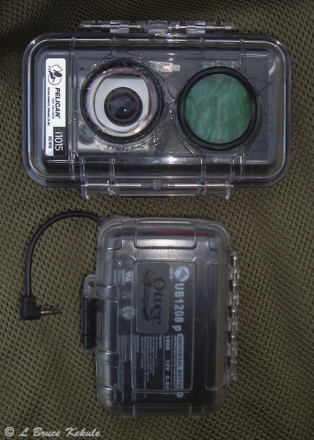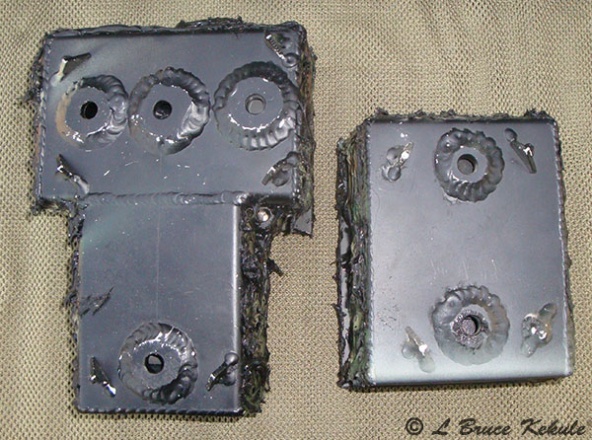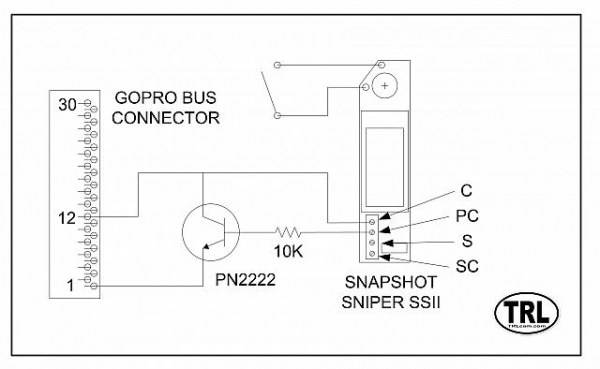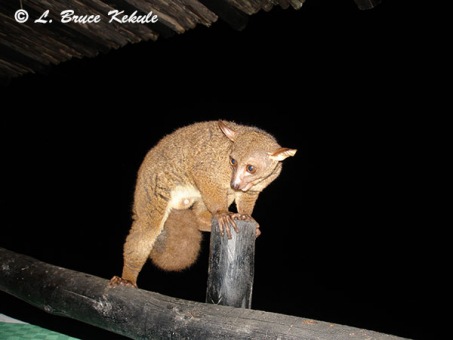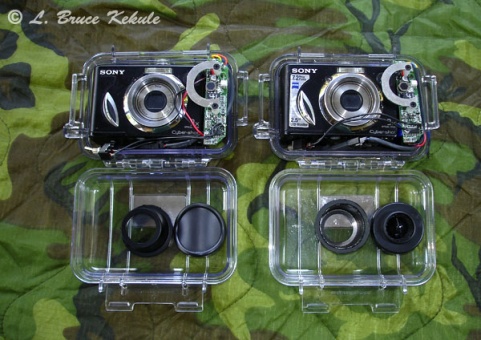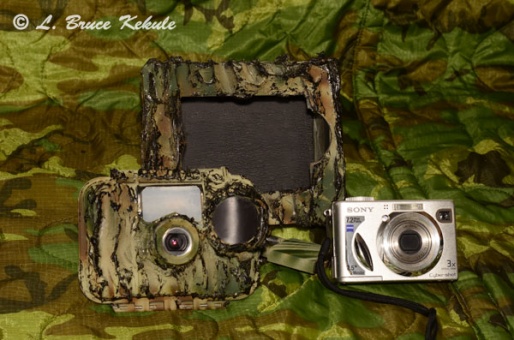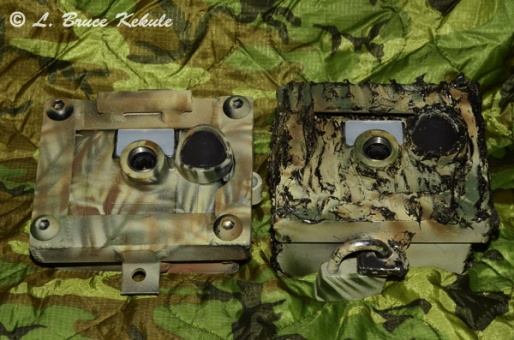Posts Tagged ‘trail cams’
‘Two ‘elephant-proof’ boxes
Custom made protective boxes for my Bushnell Trophy Cams
Finished boxes for my HD Bushnell Trophy Cams.
After using a couple commercial protective boxes with thin steel sheet metal and getting them bashed in by elephants, I thought it was about time to make-up some of my tough aluminum ‘elephant-proof ‘ boxes for my two 2012 HD Bushnell Trophy Cams. These are great little cams and I use mine exclusively on video as the HD clips are quite good but the photos only fair.
Tapping the 10mm threads.
First off, I got my welder to construct two boxes from 3mm thick plate aluminum and had him weld in some 1-1/2″ long aluminum octagon dowels in each corner. These would except 10mm ‘power torque’ machine screws. I machined the boxes flat and drilled and tapped the corners. The 6mm thick faceplate was installed and milled out for the sensor, lens and LEDs, plus a 10mm hole at the bottom for the mic.
Boring out the faceplate for the sensor.
Boring out the faceplate for the LEDs.
Milling out excess.
These boxes use two 3/8″ x 3″ stainless steel lag bolts from the inside for securing the box to the tree before putting the cam in and securing the faceplate. This alone keeps elephants at bay. The back is beefed-up with heavy duty plate and what I call ‘shark teeth’. A ‘Python’ locking cable is also installed for back-up.
Finished box in the raw.
These boxes have stood the test of time….! All my cams use this system. The tremendous power of Asia’s largest land mammal is nothing to sneeze at. They can tear them off the tree if only a cable is used. My close friend and fellow wildlife photographer, Paul Whitehead has lost quite a few cams already over in the East using only cables.
Back-end showing beefed-up holes and ‘shark teeth’.
Needless to say, I’m confident when I leave my cams in ‘elephant country’ using this system. Tomorrow I leave for the forest to set-up these two Bushnell’s in a new location in Huai Kha Khaeng, Thailand’s premier tiger country. I am hopeful that loads of good video footage will be forthcoming. Hope this helps those with elephant or bear problems. A welding and machine shop is of course needed for this job…! Good luck.
Newly finished box next to an older one.
Go Pro trail cam – Bushnell companion cam
Homebrew video trail camera and commercial back-up:
Early this year, I acquired a Go Pro Hero 2 wanting to build a daytime HD video cam for a certain tree and a long soak at my favorite workplace; Huai Kha Khaeng Wildlife Sanctuary in Western Thailand.
I also had a 2011 Bushnell Trophy Cam ‘Bone Collector’ that takes quite decent IR clips, and would set it up next to the Go Pro. The Bushnell could also be used as a security cam set to video watching over the Go Pro from a hidden position.
Visited by tiger and leopard, a huge tree at a mineral deposit deep in the forest is perfect for these cams. A myriad of other species also come down to this waterhole during the daytime like wild cattle, bears and deer, and is a sure bet for some good videos, specially during the dry season coming up.
The first order of business was what case would I use. While shopping at an outdoor supply company, I found a unique Pelican i1015 meant for an iPhone or iPod with a stereo plug inside the case with an external jack. The Go Pro and SSII board fit with room to spare. A 40.5mm UV filter and HPWA lens are attached to the case with ‘Goop’.
I also wanted an external power source and picked up a 12v SLA #UB1208p battery that fits perfectly in an Otter 1000 case. Being modular would allow different external power supplies to be used. I cut the wire in the i1015 and attached it with ‘Goop’ to the battery case. Alternative externals can be 3 18650 4.2v lithiums.
In the meantime, I sent the camera to fellow Camtrapper.com member ‘TRLcam’ to be hacked, and then visited Gary at Snapshotsniper in Oklahoma where I purchased a few of his excellent SSII boards programmed for the Go Pro.
After consultations with TRL, a 12v to 5v USB adapter was used as the easiest way to connect the 12v battery to the Go Pro.
Everything was put together and I made up an ‘elephant proof’ aluminum box with 8mm ‘power torque’ machine screws designed for the Pelican in the horizontal position, and the Otter in the vertical position. Another box was built for the Bushnell.
3D camo is made up using industrial black silicon sealant and painted with several shades of camouflage in khaki, green and brown using bamboo leaves. Simple but effective.
Security will be four 3/8” X 3” stainless lag bolts and two ‘Python’ 3/8″ locking cables for the Go Pro, and two lags and two 5/16″ cables for the Bushnell.
Both cams will be set in a week or so, and ‘setup’ and videos will be forthcoming.
I would like to thank TRLcam for his help and advice, and to Gary for the boards.
Hope this helps those interested in building a Go Pro. I might make-up an IR unit at a later date to work in parallel with this one but will have to study the components and plans first. They certainly are great little cameras…!
UPDATE:
The Go Pro attached to the Snapshotsniper SSII board will not work without the following modification:
A PN2222 resistor and a 10K transistor installed as shown is required to control the Go Pro.
Sony W7 trail cam traps African elephant, giraffe and a bushbaby..!
More camera trapping in Kenya
Elephants and egrets in Amboseli National Park by the side of the road
For the last three years, I have made an annual photographic safari to Africa catching the ‘bug’ as they say. On my first trip in September 2010, I did not take any camera traps along but concentrated on ‘through the lens’ work. It was simply amazing seeing and photographing so many animals including the ‘Big Five’. I was with a group of Thai photographers. After visiting a few of the top protected areas in Kenya for 12 days, and taking more than 90 gigabytes worth of images, you can say I’m now addicted to this place.
In August 2011, I headed a new group of Thai photographers on safari. This time I took a few camera traps hoping to set them in the bush. The first hotel was a tented camp near the famous Masai Mara National Reserve (where the wildebeest and zebra cross the crocodile infested Mara River). The camp has wildlife running all over the place including the rare bushbuck, an antelope found in only a few places in Africa. Other creatures include mongoose and genet. See my previous thread entitled ‘Camera trapping in Africa’.
This year in May, I went to Kenya once again but this time down south to some new locations including Amboseli National Park near Mount Kilimanjaro on the border with Tanzania, and then to Tsavo (west and east) national parks (together they form the largest national park in the world), plus Shimba Hills Wildlife Sanctuary near the coast at Mombasa, and finally Taita Wildlife Sanctuary on my way back to Nairobi. It was once again terrific seeing and photographing some incredible creatures of nature.
Giraffes in Tsavo (West) National Park
This year I also took a W7/1010/SS1 cam with one of my custom ‘elephant proof-boxes’ as a double or back up to the Sony S600 trail cam mentioned in previous stories. Tough restrictions made it difficult to set them up. But at one location in Amboseli NP, there was a tree right next to the road and I quickly got down from the ‘Land Cruiser’ and slipped it on with a ‘Python’ cable with my camouflage sleeves and stuck some grass and leaves around it to break-up the outline.
I left it for two nights and picked it up on the way out of the park. Low and behold, two elephants had passed the cam. The distance was considerable but the sensor still got one shot in good light. I was pleased. We then headed to Tsavo (West) national park for a three-hour drive.
As we moved into the reserve, I found a tree with loads of ungulate tracks crossing the road. It was the same drill: get down and throw the cam on quickly with a Python cable and sleeves. I let this one soak for two nights and picked it up on the way out. A couple of giraffes were caught nibbling on some leaves and the W7 worked well. We then moved further East and I caught elephants but they were reddish from the red-colored clay soil found here.
Elephants in Tsavo (East) National Park: note reddish color from clay found here
We then motored down to what I would say is one of the worst roads I have ever traveled on in my entire life. For more than thirty kilometers, the road was potholed with some large enough to swallow a small car. Hundreds of truck trailers moving in and out of Mombasa on a daily basis (Kenya’s main port on the Southern coast) have destroyed the road and causes huge traffic jams.
It was hell getting through but my driver Patrick Mjoroge was very skilled having driven safari vehicles for more than 25-years. He knew how to weave in and out but I stayed ‘white-knuckled’ for most of the way. I tried to stay cool no matter what the conditions were but it was nerve-racking to say the least.
Male ‘bushbaby’ at the Shimba Hills Resort bar
We finally reached my 4th destination on this trip at Shimba Hills Wildlife Sanctuary past Mombassa. Being near the coast, it was lush and green unlike the hot dusty plains inland. The forest was thick but due to frequent patrols by rangers, I could not slip a cam in.
That night as Patrick and I were having our sun-downers and dinner, a male ‘bushbaby’ showed up at the bar. I immediately went to my room and got the W7. These small primates are semi-habituated and addicted to bread. I set-up my cam and left some bait. It did not take long to capture some candid camera trap shots.
Bushbaby: one of Africa’s smallest primates
In the event I travel to Africa again, I will surely be taking a couple DSLR trail cams and a few video cams. The opportunity to trap Africa’s exotic creatures on digital is great and I look forward to visiting Kenya once again. I hope those interested will enjoy this thread.
Two camera traps for Africa
LBK ‘Clear-View’ trail camera project: Twin W7/1010/SSIs
Sony W7s in Pelican 1010 cases with Snapshotsniper SSI boards
In 2008 when I first began building digital trail cams, I used several different models of Sony, Nikon and Canon cameras but found the Sony W7 to be one of the best producing very good quality photographs, both day and night, with its Carl Zeiss lens set to ISO 400 in ‘program’ mode. I actually use a W7 for general photography while in the field and have come to like this model even though it’s a bit large for a digital compact compared to newer models.
W7/1010/SSI components ready for building
The W7s are robust cameras that use two AAs and are fairly quick for all-round use. The only drawback; they are tough to hack and a steady hand, good eyes and nerves of steel is needed to modify these as the connections are tiny..! Check out Camtrapper.com and Buckshot164’s video tutorial on the W5-7, or the W1 for that matter (similar camera).
By using the Pelican 1010, they are truly ‘pocket size’. I normally use two ‘Energizer Lithium’ batteries that can usually last a month or more. I bought 8 W7s and built camera traps around six of them but kept these two for a special job one day.
W7/1010/SSI cam #1
I sourced the clear Pelican cases and managed to get some of Gary’s last SnapShotSniper ‘Simple Sniper’ boards before he discontinued them. I also ordered the metal sensor mount for easier installation with epoxy. By laying the camera and the 9-volt battery in the deep end of the case and the sensor in the shallow end, everything just fits.
W7/1010/SSI cam #2
The build is straight forward, and no hole is cut in the case for the flash allowing the camera to shoot straight through. A lens snorkel and HPWA is used and there are no externals. I have tested most of the cameras in this ‘clear view’ series and the power of the flash is not cut down by the case.
In fact on these builds as an experiment, I’ve installed a flash diffuser (cut from a Nikon SB26 flash diffuser) to cut back on harsh light sometimes caused by the factory flash. This idea came from an Olympus ‘dive housing’ for their U-700 digital compact shown here. My main objective with camera trapping is close frame filling shots that really show wildlife and the diffuser just softens the flash.
Olympus U-700 digital camera in an Olympus dive housing with a flash diffuser
A couple of aluminum boxes protect the W7s/1010s and a ‘Python’ 5/16” locking cable is used plus small ‘shark teeth’ are welded on the back to lock the cams in place on a tree. Holes are drilled to accommodate two lag bolts but these will not be used where I’m going, but later when I deploy these cams in the field here in Thailand. I have made-up one with 3D camouflage pattern and the other with 4-color camouflage paint job using fern leaves.
Completed trail cams ready for the field
I have built these two for my yearly African photographic trip that is coming up on May the 1st for two weeks. I will be going to Kenya once again, but this time will be visiting the great Amboseli (close to Mount Kilimanjaro) and Tsavo (East and West) national parks plus Shimba Hills Wildlife Sanctuary (especially after sable) and finally close out the safari at Nairobi National Park.
I hope to slip them in depending on local restrictions and laws, plus available wildlife and forests in the hotels and resorts where I will be staying on the fringes of the protected areas. In most reserves in Kenya, one is not allowed to leave the safari vehicle at any time or place other than in the hotels, and heavy fines can be incurred by the driver/guide (more than a $1,000 US dollars) if they are caught. It seems unjust but some people have already been maimed and even killed by this reckless behavior.
Detail of the drilled and taped box
In 2010, I slipped a trail cam in the bush and got a beautiful shot of a giraffe in Samburu National Park and then in 2011, got several shots of the rare bushbuck (both male and female), an African mongoose and a large-spotted genet plus a night patrol ranger with a .458 Winchester M70 express rifle at Siana Springs Tent Lodge near the Masai Mara Game Reserve. It was a neat experience.
Sony W7s and Sony S600 trail cams: ‘Python’ locking cable and camouflage sleeves.
These two Sony W7s and another Sony S600 are some of my smallest trail cams and just right to take with me while flying abroad. Being little, they are easily carried in my baggage and set-up will be quick. I will post any pictures at a later date.




